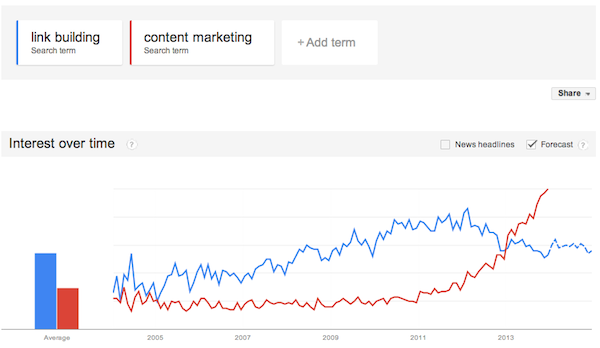If there’s one thing we heard ad nauseam in 2013 (and 2012, 2011, 2010…), it was that “content is king.” Frankly, this phrase has been said so many times that it has lost its meaning. What exactly does that mean?
Content will continue to be a key part in SEO moving into 2014. I don’t think that will ever change. But your strategy has to adapt if you’re going to keep up.
Here are five ways to make sure your content will sustain in the New Year and move you past your competitors.
1. Marketing Automation to Measure It
Dave Snyder already hit the key KPIs to measure for content marketing, which is highly recommended reading. “Content has value beyond simple search engine optimization,” Snyder wrote.
We know, and clients know, you need good content, and for a while, that’s all they needed. But in 2014, clients will demand more than “8 blog posts published” as a KPI, and that’s where marketing automation comes in.
For me, the benefit of a marketing automation platform like Pardot or HubSpot isn’t in automating your tactics; it’s in providing a better way to report and measure how your content is working for you. You can see things like:
- Content patterns: You can see if a user is only interested in one topic, and only serve them content that matches their interests.
- Sales over leads: Syncing into a CRM, instead of showing clients leads your content brought, you show them sales.
2. Smarter, and Personal, Content in Emails
On Halloween, my inbox was bombarded with “All treats, no tricks” content from email marketers. I didn’t open a single one of them.
Email marketing can be a huge supplement to traffic and sales, but it demands creative content specifically for that user: Those timeless clichés won’t work anymore. You have to find a new angle.
Stitch Fix did just that by giving a Halloween costume idea using an item of clothing I ordered from them. They knew what I had purchased, they tailored the email personally to me, and they drove me to their website.

Content doesn’t just go on your website. The right content in your email can drive an enormous amount of traffic and bring a $44.25 return for every $1 you invest.
3. Make It Available On the Move
In 2013, 63 percent of cell phone users used their phone to go online. That’s doubled since 2009.
Google endorsed responsive web design in 2012, and Google’s Matt Cutts has recently stated responsive won’t hurt your SEO, but the move to more mobile-friendly web experience brings to light a larger question with your overall content strategy.
We categorize devices in three types: desktop, tablet, and mobile. But within those sections, you’re still working against dozens of different screen sizes. Not all laptop screens were created equally, and the same goes for tablets and smartphones.
With most responsive design, when you scale to a smaller screen, the content on the right moves underneath the content on the left. But what happens when that piece of information on the left is a critical call to action? You don’t want that at the bottom when it’s on a different device.
You have to think about how your content will look on the dozens of different screen sizes your users use to read said content.
4. Separate Content From Link Building
For most, 2013 was the year that “content marketing” replaced “link building.” If Google Trends is any indication, that will continue into 2014.

Unfortunately, that’s not how we should look at content. If you’re writing content for the sole purpose of building links, you’re doing it wrong. Content – and content marketing – is a component of link building, but they’re not interchangeable.
In 2014, write content for the purpose of educating and informing, not manipulating and profiting. And when it get links, it’ll be even better.
5. Small Tastings Mixed With Larger Portions
A couple of years’ back, we wrote a lot of content on one page because it was better at attracting search engines. In 2013, we wrote 1,500-word plus blog posts because users wanted to sink their teeth into it; the more in-depth your content, the more likely people will share it.
Ain’t nobody got time for that in 2014.
Think about it: People barely have enough time to do their day job, and now you expect them to dedicate 20 minutes of their day to your blog post. And then share it? Unlikely.
Instead, offer smaller, bite-sized pieces of your content that users can easily digest and easily share. They’re not entirely unique, but taken from longer pieces that people can opt in or decide to read at their leisure. These can be data points, memorable phrases or action items and will fit nicely for Facebook or Twitter posts.
Summary
The key thing to remember is content isn’t going anywhere, not in 2014 and not ever. It’s just getting adapted to fit what your users want and how they’re accessing it.
What did I miss? What else do you need to do in 2014 to have killer content?

